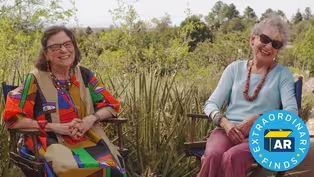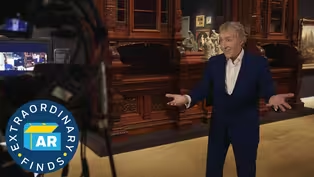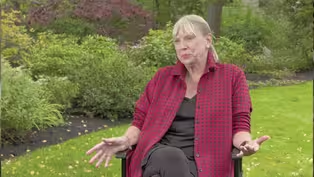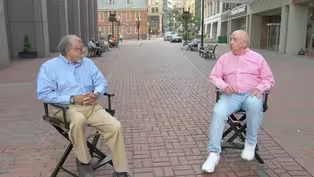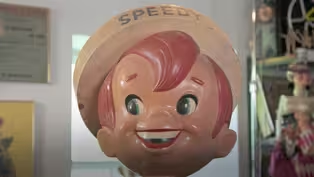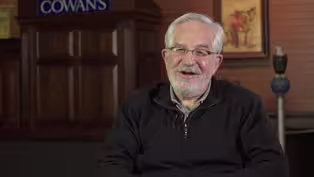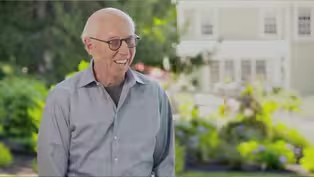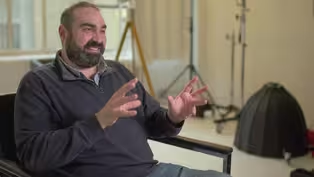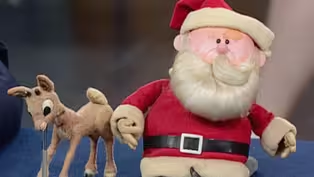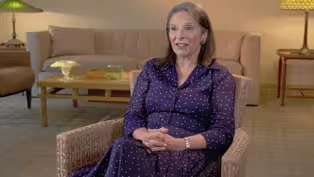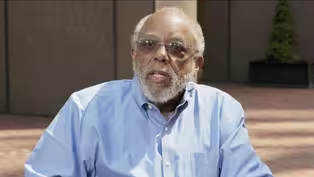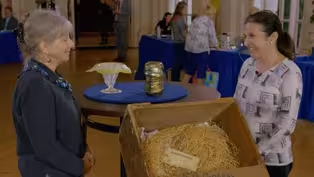
Extraordinary Finds 2
Season 25 Episode 19 | 52m 23sVideo has Closed Captions
Learn what happens to more standout treasures after the ROADSHOW cameras stop rolling!
Follow the stories behind more unforgettable treasures from ANTIQUES ROADSHOW’s history and learn what happened after the cameras stop rolling through all-new interviews with fan-favorite appraisers, standout guests, and more!
Problems playing video? | Closed Captioning Feedback
Problems playing video? | Closed Captioning Feedback
Funding for ANTIQUES ROADSHOW is provided by Ancestry and American Cruise Lines. Additional funding is provided by public television viewers.

Extraordinary Finds 2
Season 25 Episode 19 | 52m 23sVideo has Closed Captions
Follow the stories behind more unforgettable treasures from ANTIQUES ROADSHOW’s history and learn what happened after the cameras stop rolling through all-new interviews with fan-favorite appraisers, standout guests, and more!
Problems playing video? | Closed Captioning Feedback
How to Watch Antiques Roadshow
Antiques Roadshow is available to stream on pbs.org and the free PBS App, available on iPhone, Apple TV, Android TV, Android smartphones, Amazon Fire TV, Amazon Fire Tablet, Roku, Samsung Smart TV, and Vizio.
Buy Now
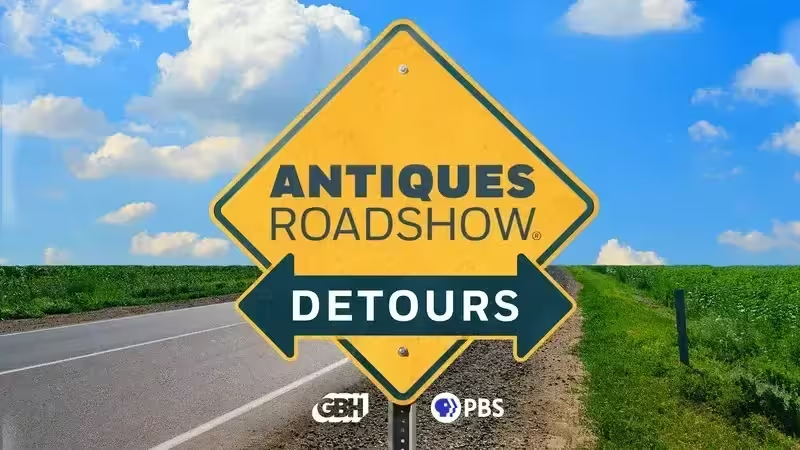
ANTIQUES ROADSHOW DETOURS
Ever wondered what happens to the treasures featured on America’s beloved ANTIQUES ROADSHOW after the cameras leave town? Host Adam Monahan tracks down the juicy afterlives of your favorite finds from PBS’s hit series.Providing Support for PBS.org
Learn Moreabout PBS online sponsorshipMore from This Collection
EXTRAORDINARY FINDS is a special unlike any you've seen before, revisiting some of our most amazing moments to answer the question: What happened next? We follow up on those fascinating stories with all-new interviews, appraisal updates and more!
Video has Closed Captions
Revisit some remarkable ROADSHOW finds whose stories didn’t stop even after we yelled cut! (52m 29s)
Video has Closed Captions
Celebrate 500 episodes with an hour of pivotal moments, amazing finds, interviews & more! (52m 25s)
Providing Support for PBS.org
Learn Moreabout PBS online sponsorship♪ ♪ CORAL PEÑA: We've uncovered some fascinating treasures over the last 25 seasons, and their stories don't stop when we yell "Cut!"
SIMEON LIPMAN: He opens it up and my heart skipped a beat.
The story just gets more interesting as we go on.
PEÑA: It's "Antiques Roadshow: Extraordinary Finds 2."
♪ ♪ Do you have a sense at all of what you're looking at here in terms of value?
I haven't a clue!
PEÑA: In 2019, "Antiques Roadshow" learned what happened to some of our show's most extraordinary finds...
When we first saw you, my heart started going like this.
PEÑA: ...after our cameras left town.
We just looked at each other, we just couldn't believe it.
Here we are with an absolute masterpiece.
PEÑA: Since then, "Roadshow" has discovered more incredible stories to share.
This is the greatest piece of glass that I was ever going to see on "Antiques Roadshow."
PEÑA: From misfit Christmas characters who found a happy ending...
It's like the best possible ending for any holiday story.
PEÑA: ...to an obscure sand artist whose delicate creations are now pouring onto the market.
I had never heard of this guy, and I was sitting at a table with two top folk art experts in the country, and they'd never heard of Andrew Clemens.
PEÑA: "Roadshow" reveals the surprising journeys of some intriguing items... KEN GLOSS: It's not the most valuable item I've ever had on the "Roadshow," but it's probably the one that I've had most personal connection to.
PEÑA: ...in an all-new hour of "Extraordinary Finds."
Wow, that's unbelievable.
PEÑA: At the Providence Roadshow in 2005, collectibles expert Simeon Lipman encountered one of those sometimes iffy Tupperware treasures.
LIPMAN: I remember a gentleman coming over, he had his arm in a sling, and he was holding a Tupperware container.
And you never know, when they've got a Tupperware container and it opens up, you don't know what's going to be in there, you don't know what it's going to smell like.
So, kind of took a step back.
PEÑA: But when he opened this guest's container, he was elated by what he saw inside.
He opens it up and my heart skipped a beat.
I'm looking at two faces I've seen my entire life: Rudolph and Santa Claus from the beloved 1964 special.
Whenever you see something iconic like that, immediately, you think, "Okay.
These probably aren't the actual puppets."
But once he told his story, things got interesting.
My aunt worked at Rankin/Bass Productions for about ten or 15 years in the '70s and early '80s, and she acquired all of them and they were the production puppets from "Rudolph, The Red-Nosed Reindeer."
He had a very, very good story of provenance.
Especially back then, people didn't really think about these things as being collectible objects, so, if somebody wanted them after the production was over, they needed the space.
And like with any other, any other prop in a production, there's usually more than one-- there has to be, because something can happen-- so I wasn't sure if these were the only ones, but I had a pretty good idea that these were real.
So what we have here are the actual original puppets.
As far as I know.
When you opened the box... Mm-hmm.
...and took these fellas out... Mm-hmm.
...it was like I was seeing old friends.
Yeah, exactly.
As I'm sure it is the case with millions of our viewers, this is a Christmas tradition.
1964 is when the film was made, and, uh, it's, definitely has a warm spot in all of our hearts.
Mm-hmm.
So to actually meet them in person... (laughs): It's really exciting!
Exactly.
LIPMAN: In this particular case, that puppet that, that appeared at the Roadshow was the young Rudolph, and Santa is the Santa we see toward the end of the program.
Including Rudolph and Santa, we had Yukon Cornelius, Hermey the Misfit Dentist, and a few others, including assorted reindeer that got melted in our attic, thanks to my mom.
We used to have them around the Christmas tree, you know, growing up, and I'm just used to having them around.
LIPMAN: The puppets did not fare well over time, but like a Christmas miracle, only Santa and Rudolph survived in the attic.
They're not in perfect condition.
Yeah.
The nose has been replaced.
I guess the bulb broke or something.
Play-Doh.
Santa's whiskers are missing there.
If I were to estimate it at an auction... Mm-hmm.
...I wouldn't estimate it less than $8,000 to $10,000 for the pair.
Mm-hmm.
What it would go for at auction, that's anyone's guess.
Okay.
About a year or so after the show aired, George, the original owner, sold them to a gentleman named Kevin, who had them painstakingly restored, with Santa getting his whisker back and Rudolph getting a light bulb put back in his nose, and they look great.
Those puppets were then sold to a big-time collector named Peter.
As the years went by, I had a different opinion of what the value was.
Now that they've been restored, and things from our childhood, the nostalgia surrounding them, certainly in this day and age, these things have taken on tremendous value.
I wouldn't be surprised if it sold well over $100,000, maybe more-- I believe they are that iconic.
They're that important.
I look at antiques and, and these pieces as time travelers.
This is part of their journey and this is part of their story.
PEÑA: But Rudolph and Santa's journey didn't end there.
A few months later, we caught up with Simeon again to hear about the latest chapter in the life of these beloved Christmas characters.
Since we last spoke during the summer, we've had some exciting news regarding our friends Rudolph and Santa.
And, uh, boy, uh... What a perfect ending they, they had.
So in November 2020, Peter decided, uh, to place Rudolph and Santa in a, in an auction, and it went to Profiles in History in California with a pre-sale estimate of $150,000 to $250,000.
AUCTIONEER: And we have one opening bid of $150,000.
Looking for $160,000 next.
This is the screen-used Santa and Rudolph from the beloved story of "Rudolph, The Red-Nosed Reindeer" worth $190,000... $240,000.
Lady's bid on the phone, and back to the internet, $250,000.
Okay, we have a bid now split at $262,500... After frenzy of online bids and live bids... AUCTIONEER: Going once, twice-- all done?
And... (bangs gavel) Sold.
LIPMAN: With the buyer's premium, that brought the total for Santa and Rudolph to $368,000.
The next chapter for these wonderful pieces, which made me so happy: the buyer, an anonymous bidder, donated them, and they will have a semi-permanent home at the Center for Puppetry Arts in Atlanta, which is just a fabulous museum devoted to puppetry, the art of it, and the puppets themselves.
For the past 15 years, I've been kind of, sort of attached to these things, kind of publicly!
To actually get to be a part of this saga and this story along with the "Antiques Roadshow" has been a real pleasure for me.
And for it to end up in this place is, like, the best possible ending for any holiday story.
Somebody's generosity has factored in to these now being available to the general public to enjoy, is, is a real pleasure, and I'm really thankful for that.
This is a Tiffany lava... PEÑA: From puppetry arts to decorative arts.
Now the story of how longtime Tiffany expert Arlie Sulka finally found her Holy Grail at a rainy Roadshow in Newport, Rhode Island, in 2017.
SULKA: In Newport, we had the threat of a hurricane and it was our first outdoor venue.
But the show did go on.
This lady was pulling this cart with a crate, it was a bit unwieldy, and she pulled out a piece of glass from the crate and put it on the table, and my heart practically stopped, because I had been waiting for that piece of glass for almost 20 years.
I ran over to the volunteer, who had to radio the producer, and I said, "Whoever you're calling, please tell that producer that Arlie has found the Holy Grail."
This is the greatest piece of glass that I was ever gonna see on "Antiques Roadshow."
During the Depression, my aunt started buying up these vases from Tiffany's.
So I guess she ordered some by the crateload.
On the side, it actually says "Louis C. Tiffany Studios."
It's not often that people keep the shipping crates.
So let's talk about what you have.
The first piece of glass, which is what we would call pastel glass... Mm-hmm.
...is later-production Tiffany.
Okay.
It was made in the '20s, it was made in multiples, and it came in different colors.
SULKA: Usually when you see pastel glass, um, that Tiffany made, they're mostly utilitarian pieces-- it's serviceware.
This was a little more of a standout piece because it's an art glass vase.
That vase was not meant to ever have water or flowers in it.
The flowers are actually in the vase already, so it was the best of its kind, but it wasn't as good as the other two pieces.
Now, this piece is a paperweight glass vase.
Mm-hmm.
Leslie Nash, who worked for Louis Comfort Tiffany, claims that while they were working with paperweight glass, Louis Tiffany himself, who was a painter, came into the glassworking shop, handed them a painting of morning glories that he had painted and said... Ah... "I want you to make this in glass."
Wow.
1914 is when they first introduced it.
Your piece, on the bottom, says "exhibition piece" on it.
And I know from the date letter on it, which is a suffix L, that that would be somewhere around 1915.
So it's possible that this could have gone to the 1915 San Francisco International Exhibition.
Okay.
Most major museums would like or already have a morning glory paperweight in their collections.
A morning glory is something that Tiffany collectors aspire to have in their collection.
Tiffany was very proud of it, and this was an exceptionally lovely piece.
So, just to give you an idea of value, the, the crate, in a retail setting-- this is something for Tiffany geeks everywhere, collectors, museums-- they would actually be very excited about this, and it would be worth between $5,000 and $10,000.
Holy cow!
This piece, which is not as sought-after as some of the other art glass... Mm-hmm.
...would retail in probably between $2,000 and $3,000.
Uh-huh.
But this piece, in a retail shop, it could be sold for anywhere between $50,000 and $75,000.
No way!
Oh, my gosh!
I was... thinking maybe, $8,000 to $10,000, I was hoping-- wow.
Well, that was a long time ago.
Wow, I, I really didn't know what the market had done.
You know, if it had gone sideways or up or down, but wow.
(inhales through teeth) So there's one other thing in here that I want to talk about.
This vase.
This practically stopped my heart... (chuckles) ...when I saw it in the box.
This is the piece I was waiting for for 20 years.
Oh, wow!
And what I can tell you is, every night before the Roadshow, people would always say, "What is on your wish list?
What would you like to come into the show tomorrow?"
And I always say, "A Tiffany lava vase."
Wow.
And that's what this is.
It's extremely special.
It is meant to look like molten lava on the surface of the vase.
Mm-hmm.
And this one is particularly interesting, because you also have these protrusions here.
And it's very similar to a vase that was shown in the 1906 Paris Salon Exhibition.
Oh...
The thing about lava is, it was very hard to make.
They get cracked in the making.
Oh.
And I did go over your lava with my special light and a magnifying glass, and I couldn't find any imperfections.
SULKA: Lava glass evolved out of a different type of glass that Tiffany first started to make in the late 1890s.
That was called Cypriot glass.
And the Cypriot glass was made to imitate the excavated glass that was found on Cyprus in the late 19th century by Luigi Palma di Cesnola, who gave all of what he found to the Metropolitan Museum.
And we know that Tiffany saw that glass and it did inspire him to reproduce what nature had done to the glass in the studios.
This was a very difficult, multilayered process.
It's not what you normally see or what you expect to see with Tiffany.
Most people identify immediately with the gold and the blue iridescent pieces of glass.
Those are the most widely recognized.
When you get into the more extreme art glass, uh, this is the top rung.
An example like this in a retail shop could sell between $100,000 and $150,000.
(laughing) Where's my brother?
He's gonna... (laughs) Wow, that's unbelievable.
I had no idea.
Two years after Newport, in the fall of 2019, Susan and her siblings contacted me and said they were ready to part with the pieces.
And they said, "And do you want the crate?"
And I said, "Of course I want the crate!"
So they drove down to New York and they brought me their three pieces and the crate.
What I did was, I bought the pastel vase and I bought the crate.
I actually didn't buy the morning glory, because, um, Sue said it was just very sentimental because her aunt had given it to her when she graduated either from high school or from college, and so she really wasn't ready to let it go.
But I don't think she was particularly interested in keeping the lava vase.
I always tell people they, collectors, you should buy what you like.
And in this case, I don't think that she liked that piece all that much.
It wasn't getting any more beautiful even though she found out that it had great value.
I made an arrangement on the lava piece that I felt that I could place it in a private collection, which I did shortly thereafter.
I sold it on their behalf and placed it in that collection.
As a dealer, a transaction between a, a buyer and a seller is kept confidential.
It's not like an auction where all the results are publicly noted.
So while I can't reveal what was paid for the piece, I can say that the, the buyer, the seller, and the in-between person were very pleased.
PEÑA: "Roadshow" recently visited famed folk art expert Allan Katz at home in Madison, Connecticut, to learn about a 19th-century schoolgirl needlework he first discovered in Denver in 2009 and the truly touching story of what's happened since.
When our guest Suzanne came to the table, she took it out of the box.
Just immediately, the word "spectacular" went through my brain.
I inherited this needlework from my mother.
It was actually done by my great-great-grandmother, who was from Ohio.
KATZ: She claimed it was a family piece, that it was made by her great-great-grandmother, a woman by the name of Maria Koogle.
The identity of the maker is very, very important, that then we can trace where she was from, what family she was from.
We know that she was born in 1803.
Correct.
And the family history says that she was about 14 years old when she made this.
Yes.
So we're dating this to 1817.
1817.
We see a lot of samplers on "Roadshow" from 1830, 1850, and we say, "It's not old enough."
Because the market really wants samplers that were done from the late 18th century right up to about 1825, 1830.
This one has some very, very special features.
It's silk thread on a silk background.
Mm-hmm.
The color of this is so extraordinary.
The blues are totally rich, the sky.
It really has an extraordinary composition.
The sampler collectors are very, very particular, and for sure, condition is a, a huge role in determining value.
The condition was marvelous.
The colors, the blues were like the day they were made.
Now, have you ever had the piece appraised?
After my mother passed away, somebody who came to the house who was an antique dealer in Phoenix did offer me, first $3,000, and later, when she came back, she offered me $6,000 for it.
Okay.
KATZ: She said that she would never sell it.
The piece had always passed to the eldest daughter in the family lineage, and that, um, she just wanted to know really what it might be worth, and we placed a retail value on it that day in Denver.
I would put a market value on this piece of around $40,000 to $50,000.
Oh, my.
(laughs) Now, for insurance purposes, what... For insurance purposes, I would go $50,000 to $70,000.
Oh, my, okay.
Shortly after the Denver Roadshow, our guest contacted me and I did provide her with an insurance letter.
About eight, nine years later, in the fall of 2017, I got a phone call and it was our guest, and she said, "Due to some health issues, I think I will need to sell that."
What followed was about a four-week dialogue between us, where she was having anxiety about parting with this piece and felt guilty about selling it outside the family now.
Finally, we drew up a contract.
I represented her, and we finally received the needlework-- so we're now in October, and I immediately had it photographed.
What I decided to do is give our guest a surprise Christmas present.
I blew up the needlework with high-def photography to the exact size of the original.
I found an antique frame, and an old piece of glass with bubbles in it.
I actually made a copy for today.
And especially when you put it under a piece of glass in an old frame, you would think this is real.
When Suzanne opened the box and took out the piece that we had made, she was fooled by it.
She thought we were returning her original piece, and it took me a good two, three minutes to explain to her what we had done and that that was hers to keep.
And she would still have a strong piece to remember the original by, and also something that could be passed along to future generations with a wonderful storyline.
We did some research and I had asked our guest Suzanne for a family tree.
I saw in that family tree that Maria Koogle was not her great-great-grandmother.
First of all, there was many more generations in the 200 years, but rather about three generations later, the piece was inherited by an aunt, and the aunt had no children, and therefore passed it on to a cousin in the family.
So our guest in Denver inherited this through the cousin line of the family tree.
The other thing that we were able to ascertain, there is no print that resembles the layout.
So it was a unique composition, a unique piece of art, and the drapery proved to be very, very unusual-- not seen anything like it.
So we had a lot of pluses that were now adding up to change the piece from spectacular to extraordinary.
I did market it and we did successfully sell it for slightly over $100,000.
I spoke to Suzanne about a week ago, and she's delighted and we'll never forget our "Roadshow" experience.
And just another, another good story, and another good thing that "Roadshow" has done for one of our viewers.
PEÑA: And now for an entirely different kind of folk art.
20 years ago, appraiser Wes Cowan had never heard of Andrew Clemens, a young man from McGregor, Iowa, who, in the late 1800s, mastered the meticulous art of filling bottles with colored sand-- grain by grain.
But that all changed dramatically in 2002, when a guest named Tom Ellsworth brought his fragile heirloom to the Hot Springs Roadshow.
I was at the folk art table, and a gentlemen walked up and he showed me this bottle that was filled with sand, but it wasn't just a bottle filled with sand.
It was an unbelievable construction.
I took one look at it and I just, my mind was completely blown.
We're not really sure what to call it.
(chuckles) But it's colored sand in a jar.
And it was presented to my great-grandfather around the end of the Civil War.
He was a surgeon in the Union Army, I believe from New York.
And this was a gift from two of his friends, and it's been in my family ever since.
Let's start with who your great-grandfather was.
He didn't come from New York.
Did he not?
He came from Illinois, and he spent most of his Civil War career in the Hot Springs, Arkansas, vicinity.
The real interesting thing about this remarkable piece of sand art, though, is just what you see here.
Not only is his name on it, but on the back, you see this wonderful eagle with a 36-star flag.
You spin it around, you see his name is written in script, there's a mortar and pestle.
All of this is done with individual grains of sand.
And when you flip it up, the label on the bottom says, "Pictured Rock and Sand by A. Clemens, Deaf Mute from McGregor, Iowa."
I had never heard of this guy.
And, in, and I was sitting at a table with two top folk art experts in the country, and they'd never heard of Andrew Clemens!
So, um, it, it was a real moment of discovery, I think, for all of us.
He went to the deaf-mute school in Iowa and would come home in the summers and he started going to this spot on the Mississippi River in McGregor, Iowa, and collecting sand and started experimenting with making these bottles.
He used a great big, oversized fishhook and, like, a popsicle stick, and he would pack it in this bottle and manipulate it with the fishhook.
By the time he was about 17, he, he was really into it, and from 17 on, until he died, he was basically working with this colored sand that he was collecting locally.
We know that for part of his career, he, he sat in the front window of a grocery store so people could watch him make bottles.
He also apparently worked at the family home in front of a window there.
He actually had a, a rate sheet, uh, that he had printed up.
"Pictured Rock Sand from Andrew Clemens, McGregor, Iowa."
If you want to order a bottle that's a, a half-pint or a pint or a quarter-pint, if you wanted a marine scene.
He advertises a locomotive, a sailboat, steamboats.
All of these were priced differently.
The fact that he had this rate sheet printed shows that, you know, he, he was peddling these things far and wide, or trying to.
The Iowa State Museum has Clemens's masterpiece bottle, which he made for his mother, that has George Washington on horseback, has a steamboat, has the state seal of Iowa, all on the same bottle.
It's absolutely mind-blowing.
It is a remarkable piece of folk art.
On today's market, I would guess that it's between $4,000 and $6,000, is what we'd estimate.
Really?
It might bring more than that in the right auction.
Great piece.
That's great.
The market for Clemens sand bottles, um, has been, it's been pretty astonishing.
The, the market perked along for a number of years where bottles were selling for $5,000, $10,000.
2015, 2016, a couple bottles, um, brought $35,000 or $40,000.
I didn't sell those for, for that amount of money.
And I was, I remember being, "Whoa, that's pretty astonishing.
That much money for one of these bottles."
The next time we had a bottle, I think I had it estimated...
I, I can't even remember, $30,000 to $40,000.
But I do remember there were phone bidders, and I remember it blowing past $50,000, $60,000, $70,000.
It was like a, there was a, like, "Really?
"Are you serious?
Somebody's paying..." This is, this is, like... With the buyer's premium, it's, like, $100,000.
This is serious money.
Then six months later, I had two more.
Both of them sold for more than $100,000 in the same auction.
The owner of the bottle, the, the gentleman that I interviewed first in Hot Springs in, you know, almost 20 years ago, contacted Cowan's last spring, and he said, "We've made the decision to sell the bottle.
And, um, would you like to handle the bottle?"
Well, duh, of course!
We were prepared to drive down to Arkansas, pick the bottle up, and kept waiting to hear from the gentleman when we could do it, when we could do it, and the next thing I know is that, "Well, you know, we've made other arrangements."
(chuckles) I suspected knowing, uh, who had sold other bottles, that it had to be, you know, one of maybe three or four other places that had sold the bottle, and lo and behold, it was Skinner.
PEÑA: By a strange coincidence, it turned out that Mr. Ellsworth's son was an old college friend of another "Roadshow" appraiser, LaGina Austin.
And when he reached out to LaGina at Skinner Auctions in 2020 for help selling his Clemens bottle, LaGina was excited to oblige.
AUSTIN: I received a message from someone I had gone to college with that his father had something he was interested in, in selling.
And after a week of back and forth, he finally said yes, he wanted to sell it.
We came up with $50,000 to $75,000.
During the pandemic, we're doing either timed online auctions, or we're doing virtual online auctions.
The auction that this sand bottle was going in was going to be a timed online auction, and it was going to run from November 13 through November 23, so it was open for bidding on November 13, and almost immediately, as with all online auctions, there was a flurry of bidding.
It had a bid of $40,000, and it sat there for about a week.
A lot of times, the action doesn't take place till the last day, sometimes within the last hour.
So the last day, I, I'm working from home.
I kept refreshing it all day and it sat at $50,000.
Finally, it got up to $75,000.
So I was, like, "Okay, it, it made the high estimate," sat down to eat dinner, and then I get a text from Mr. Ellsworth.
He said, "Wow, it's really taken off now."
And so then I dragged the computer back out at the dinner table, and my family and I all watched it as this happened in the last probably 15 or 20 minutes of the auction, that it hammered at $220,000.
And then, with the buyer's premium, $275,000.
Then I got a text from Mr. Ellsworth and his son.
Both, "Wow."
You know, everyone was just amazed.
I thought it could certainly reach $100,000 or more.
I didn't know that it would break the $200,000 mark.
I did some quick research and figured out that it was, in fact, a new record.
And so it's a...
It's an amazing thing.
These sand art bottles, they're rare, they can't be reproduced, or if they can, that would be... (laughs): I would like to see the person who could reproduce that.
If it gets damaged, then you're left with nothing.
So the interest is what would drive the interest in any extraordinary object.
I have no idea how many bottles are, are left out there, but I do know, once an auction price such as this is achieved, at $275,000, that they'll start coming out of the woodwork.
PEÑA: From sand art to bird art.
Paintings expert and self-described nerd Colleene Fesko couldn't believe it when she was contacted by a prestigious museum about a parrot painting and other items she'd appraised in El Paso in 2011.
She was even more surprised when she realized which part of the varied collection they were really after.
FESKO: This gentleman Brian came up to the painting desk, and what I first noticed was the beautiful watercolor of a parrot, and then he showed a wonderful drawing, a very detailed drawing of a big cat.
And then, three journals written by the guest's grandfather.
His name was Tom Ring.
My grandfather went on an expedition for the American Museum of Natural History in 1913, and Fuertes was the artist on that expedition.
My grandfather wrote journals and Fuertes put drawings in the journals and gave my grandfather these paintings.
Let me tell you a little bit about Fuertes.
He was always interested in nature and birds and animals.
He ended up illustrating many, many books.
One of the things that he also did a lot of was to hire himself out as the artist for these expeditions.
I was excited, because Fuertes has always been a favorite of mine.
I love ornithological imagery, and Fuertes is one of the most important ornithological artists of his time.
We experts on the "Roadshow" have in some ways a very narrow vision.
We see something, and we know why it's important, and don't think of the myriad of other reasons that it might be important, as well.
I was focusing on the Fuertes watercolors and the drawings, thinking that was really interesting.
But what I was first fascinated about was really three steps away from the whole story, and...
The story just gets more interesting as we go on.
Sketchbooks are very funny, because there's no great way to present them or to discuss them, because they're so intimate.
Mm-hmm.
But between your grandfather and Fuertes, they really captured the very, very best of expedition-style sketchbook keeping.
Tom Ring was quite a guy, I mean, he was a real outdoorsman, hunter.
And when he was in Colombia, he was probably 24 or 25.
So a young guy from Michigan going out there and... Fuertes wasn't much older.
It was hard, hard, hard work.
They were on mules, they were on boats, they were on steamers.
They mentioned one time in the, in the diaries that it was supposed to be the dry season, but it rained twice a day.
The bugs, the mosquitoes, the animals... That was real jungle.
(laughs) This is a wonderful example of a study of a group of birds.
This is my favorite.
That's, actually, that's my favorite, too.
And this is something that you don't really see with Fuertes very much, which is the human figure.
Mm-hmm.
He was much happier with animals.
In terms of the value of the pieces, Fuertes, a highly, highly collected... Oh, really?
...naturalist artist.
Mm-hmm.
I would estimate the parrot at between $5,000 and $7,000.
Wow.
The hunt scene at $3,000 to $5,000.
Okay.
And the three sketchbooks, which also include other drawings, at $3,000 to $5,000.
Well, great!
Shortly after the appraisal was on television, I was contacted by Paul Sweet from the American Museum of Natural History in New York.
And you all know what, what nerds your appraisers are.
So getting a call from the museum was like getting a call from Mick Jagger to me.
I mean, it was-- I was so excited that they were calling and so excited that they were calling about something that I had appraised.
And of course, I thought, because my appraisal was so based on it, that it was about the Fuertes watercolors and drawings and the pieces that were in the journals.
But in fact, he was most interested in was the journals.
The museum has academic journals.
They're very, very, very scientific.
Tom Ring was just talking about the day-to-day of that expedition that gave them a boots-on-the-ground view that they didn't have before.
When Brian heard about the museum's interest in them, he was very happy with the idea of donating them to the museum.
The museum has many Fuertes.
So, Brian kept the two works on paper.
The journals are now kept in the archives of the department of ornithology at the American Museum of Natural History, and they're available to scholars or people doing research on that expedition.
If I did the same appraisal for Brian today as I did in 2011, the values would be very similar.
The monetary value of the journals hasn't changed, but the intellectual property of them has gone up a great deal, because this just adds a flavor to the expedition notes that didn't exist before.
PEÑA: "Peanuts" fanatic Phil Weiss found his so-called ideal scenario in Los Angeles in 2006, when a guest named Arnold brought in a knockout portfolio of Charles Schulz comics.
But Arnold's special connection with Schulz made this cartoon collection extraordinary.
It's one of those things where, when you go to do a Roadshow, you're always saying, "Gee, what would be your ideal scenario for a show like that?"
And this was it-- this was it.
I worked for Hallmark Cards in Kansas City, Missouri, before moving to California 33 years ago.
I was a "Peanuts" fan for a long time, and came up with the idea to use "Peanuts" on greeting cards, and I had to sell the idea to the creative committee.
As a result, they ended up with a whole big line of Hallmark "Peanuts" products, and I went out to work with Charles Schulz in 1960 for the first time, and worked with him for 12 years in developing all the Hallmark "Peanuts" products.
And he gave me some of this original strips and some of the original artwork.
This was a group of drawings that he did for a product we called "Snoopy's Daily Dozen."
It was an exercise booklet.
Okay.
And this is an original strip that he signed.
These are pencil drawings of some of the greeting cards that we develop.
We would come up with the ideas for the greeting cards, he would do the pencil sketches, send them back, and we'd come back with, with little fixes, like, "Make this a full figure," or, "Add bells here," and this is Schulz's pencil, and these are my penciled comments on them.
These are Sunday strips, and then this is an original strip that he did from 1957 to '59, and it's called "It's Only a Game."
He was a great, humble person that had a tremendous insight into human nature, as, as millions of "Peanuts" fans will tell you.
Sure.
I idolized this man's talent.
To meet him and work with him for 12 years was, was just great.
That's great.
WEISS: Well, you could see all the roughs and all the ideas, and Arnold said he would look at them, and they'd come back and forth, and they were kind of collaborating on the stuff.
If you think about it, um, he really is, probably, the, the driving force that, that created Schulz's work with Hallmark and that went on to so many other things.
I can't think of any young kid that didn't, at one time in their life, get a Snoopy card or a Charlie Brown card.
Arnold played a very important role in, in American culture.
Let me give you an idea on what you have and what the value is.
Okay.
There are three factors when I'm doing an appraisal like this that I'm gonna take into consideration.
First is freshness to the market, and obviously, it's never been out on the market.
Second is the age of the material, and it's really vintage, perfect "Peanuts" period, late '50s into the early '60s, nothing later than that.
And the third factor is the characters involved.
Everywhere you look, you see nothing but key characters.
Snoopy, Charlie.
Linus.
Linus, Lucy.
You have 14 of these daily exercise large panels.
The estimates I'm gonna give you are basically conservative auction estimates, and the sky's the limit when it comes to Charles Schulz stuff.
It's the hottest comic art right now on the market.
Okay.
Easily, I would estimate each of these at $6,000 to $9,000.
Each?!
Each-- each piece.
(chortling) Now, there's 14 of them, okay?
Right.
Now, when we go up here onto your daily, it's fantastic.
You have Charlie in all four panels.
Again, conservative estimate, $8,000 to $10,000 for that daily.
When you jump up here to the pencil roughs, you have a nice little grouping here.
Not as attractive to collectors, but still historically very important.
And a conservative estimate on that would be $4,000 to $6,000 as a group.
When you come over here to "It's Only a Game," since it's not a "Peanuts"-related strip, I don't know if it's going to be as interesting to the "Peanuts" collector, but still, you got to estimate these at $4,000 to $6,000 each.
Now, Sunday pages are really desirable, and these are terrific.
On the conservative side, I'm gonna estimate these anywhere from $12,000 to $18,000 each.
(laughs): My God!
I think if you add it all up, I wouldn't be surprised to see you come out anywhere from $150,000 to $200,000 on a piece-by-piece basis.
You're kidding.
You're kidding.
Absolutely not-- and if you're gonna insure it, you'd probably want to insure it for a little bit more than the high estimate.
I, I was going to say... Yeah?
I, I had these on a shelf in my closet, and I think... Not a good place for them anymore.
(laughs): Not a good place for them anymore.
No, absolutely not.
Wow.
I think he was shocked by the total value by the time we were finished cataloguing and adding everything up.
So that was the exciting part, that it was a fresh find, he didn't know what it was worth.
And the story was phenomenal.
The odds are that you're not going to hear from the guest afterwards.
But he did reach out to me and asked if I would do an appraisal for him for insurance purposes, a written appraisal.
I was happy to do that, I reached out, I gave him the appraisal, and I let him know that if he ever decides he wanted to part with the collection, I would be happy to help him.
Which never happened-- I never heard from him.
Somebody eventually let me know, he sold the majority of the collection to the Charles M. Schulz Museum here in Santa Rosa, California.
I have no idea what the terms of the sale were or what it was, but that's where it's now residing.
They're gonna make sure they stay safe, taken care of, archived, and that's part of Schulz history.
So I think he would, he did the right thing.
Collecting in general is usually generational.
So people who are in their 40s, 50s, even 60s, who are earning a living and have expendable income, they want to buy back their childhood.
That to me has always been the name of the game.
"Peanuts," it's an iconic, collectible artwork, so people are always going to be drawn to that and they're going to keep buying it.
There's a lot of it, it's not rare, but the market level is staying where it is right now.
PEÑA: From a legend of the funny pages to an icon of news photography.
In the mid-1970s, racial desegregation efforts in Boston's public schools led to frequent protests by those who opposed the city's court-ordered busing policies.
The unrest boiled over near City Hall one morning in April 1976, when a white teenager used an American flag to attack Ted Landsmark, a young Black lawyer who was passing through the plaza on his way to a meeting.
News photographer Stanley Forman captured the moment indelibly in a Pulitzer Prize-winning photo that came to be known as "The Soiling of Old Glory."
♪ ♪ GLOSS: We're standing on Boston City Hall Plaza, Boston City Hall in the background, the plaza off to the right.
We're right at the location where it happened.
We were doing a Roadshow in Sarasota in April of 2018.
I'm at the book table and autographs.
In walks a man with a classic Boston photograph.
My father was city editor at "The Boston Herald."
He assigned Stanley Forman to a photography shoot at a demonstration.
The demonstration on City Hall Plaza in April of 1976 was planned.
Louise Day Hicks from South Boston wanted to drum up resistance to integrating the schools.
She gave a fiery speech at City Hall.
She wanted to get a visceral reaction.
These events weren't planned as an act of violence, but all over the city, there were acts of violence at almost all of these demonstrations.
This picture of a Black man being grabbed by some of the white students, essentially being assaulted by the American flag, summed up everything of the civil rights, race relations in the United States.
It's a photograph that, being from Boston, I had seen many, many times, and on top of that, I even knew the photographer well.
Stanley Forman is a photojournalist, he worked for "The Boston Herald," two-time Pulitzer Prize-winning photographer.
Ted Landsmark is a Distinguished Professor of Public Policy and Urban Affairs at Northeastern University, a very, very, well-known figure in the Civil Rights Movement, especially in the Boston area, but all over the country.
PEÑA: 45 years later, Stanley and Ted agreed to meet at the scene of the incident to talk with "Roadshow" about their recollections and that iconic photo.
Good to see you.
It's really good to see you.
(laughs) ♪ ♪ On that morning, I was not aware that there was any kind of demonstration going on.
So when the kids turned the corner, I saw them and I thought, "Well, I can just keep walking and I'll walk right by them."
And all of a sudden, I looked down the plaza here, and I saw a Black man taking the turn and I just knew they were going to get him.
It was like the Black men were going through the gauntlet and they were kicked, spit on, food was thrown, yelled at, and I just charged down the steps and ran over and I captured the image.
I would have to say that I was attacked almost exactly where I'm seated at this moment.
One of the kids jumped up and hit me, which knocked my glasses off and broke my nose, and I stumbled, and what one sees in Stanley's photograph, um, is me as I am standing and being held by one of the young people, as the flag bearer is swinging the flag at me.
And because it was swung, rather than used as a spear, I wasn't impaled.
That would have had, been a very different outcome.
And the flag itself missed me, probably by two inches-- three inches at most.
But the whole thing happened so quickly that it was really impossible for me to assess what was going on.
And it wasn't until the crowd had then run off to their next destination, and I was left standing, just about right here, by myself, that I appreciated what had happened to me.
Back at the office, I developed the film, and they were very concerned.
"What do we do with this picture?"
They were really frightened of it.
And there was a lot of conversation I wasn't a part of, but I knew it was going on, and they were saved because Howard Hughes died that day.
And the top of page one, "Howard Hughes dead," and they were able to put the flag picture, "The Soiling of Old Glory," in the bottom half of the page one.
LANDSMARK: The photographs were used to identify the young people, so they were brought into custody very quickly after the incident.
And none of them had criminal records prior to that incident.
And so they were asked whether they would apologize, and I was asked whether I would accept their apology so that they wouldn't have a criminal record.
From the beginning, I felt that they were not the culpable individuals, that it was the elected officials who had basically set them up for this who needed to be held accountable.
And so I accepted their apologies and none of them served any time.
I was anxious, actually, to meet the photographer, because you had won... That was my... Yeah.
...the Pulitzer in the year before.
I was certainly aware of your work.
Well, thank you, thank you.
And I've often joked since that if something horrible is going to happen to you, it's really helpful to have the previous year's Pulitzer Prize-winning photographer handy.
Stanley, as the photographer of such an iconic image, and I are clearly bonded, and we have shared that moment, but also the legacy of that moment, in many ways since then.
We've been friends and colleagues for decades.
I do have a copy of Stanley's photo, and it is in my office, so that the young students who come in will have some sense of some of the things that I have been through and some of the things I care about.
I was rather surprised that "Antiques Roadshow" reached out to me.
I was sort of curious as to whether you were interested in talking about the photograph as an antique or talking about us as antiques.
(both laugh) Both!
I had no idea that my image was being appraised on the "Antiques Roadshow."
Ken Gloss contacted me-- I've known Ken forever.
And I said, "Oh, Stanley, by the way, I appraised your photograph at the Antiques Roadshow."
He asked me, "What did you appraise it at?"
GLOSS: It's an absolutely fabulous photo.
I have not seen many signed copies turn up, but I would say, conservatively, on a retail basis, $2,000 to $3,000.
Really?
Real...
I mean, it's such an iconic photo-- it's fabulous.
I appreciate it, thank you very much.
By the way, Ken, I didn't think you appraised it for enough.
(laughs) But, you know, I'm not an appraiser, I'm me.
This was in 2018, so it wasn't that long ago.
I would say the price that I appraised it at is about the same.
I've been doing the "Antiques Roadshow" for over 20 years now, and there are a lot of items that come in that have been great, you really enjoy them.
But this was one that, the minute I saw it, "I know this, I know the photographer!"
I knew who Ted Landsmark was.
I remember the event happening at the time.
It's not the most valuable item I've ever had on the "Roadshow," but it's probably the one that I've had most personal connection to.
♪ ♪ And these are strict... PEÑA: Last summer, "Roadshow" paid a visit to toy aficionado Noel Barrett at his home in Eastern Pennsylvania, where he shared the story of a massive mascot that ended up as a centerpiece of his own eclectic collection.
BARRETT: It was in Milwaukee, 1998.
It's exciting when you're sitting at the table and you're waiting for something to come in, and you see the crowd.
And all of a sudden, you see something above people's heads.
It comes up to my table and I'm just... (blows out) I mean, you know, once in a while, you get something that just knocks you, knocks your socks off, and this did.
I was working at a bakery in Los Angeles in 1969.
And my supervisor told me to throw all the junk out of the attic that was in the bakery.
So I threw all the stuff out in a dumpster with the exception of Speedy.
I thought he was kind of cute, and thought I'd take him home.
What you have here is an absolutely wonderful advertising figure.
I understand you've done a little bit of research trying to figure out the value.
The only Alka-Seltzer figures that I saw were about six inches high.
Uh-huh.
And they were about $150.
I don't have a clue as to something this big would be worth.
You're right, the little small figures are the ones you see all the time, and they are worth $300 to $400, $500, depending on the condition.
This is a wonderful piece.
I've never seen this particular size before, and it is absolutely astounding.
I would expect that a collector today would be thrilled to pay $4,000 to $5,000 for this incredible Speedy the Alka-Seltzer, so... Well, he's as good as gone.
(laughing) What's that?
He's as good as gone.
(both laughing) People always ask, "Do you ever get a chance to buy that stuff on the 'Roadshow'?"
And one of the rules for sure is, we cannot buy anything at the show.
We cannot offer any money to somebody there.
But I've had people call up after the show, say, "Would you like to put it in your auction?"
"Absolutely."
I don't think I've ever had somebody call me up and say they want to sell it.
Well, it did happen.
About six months later, the guy called me up.
He said, "Hi, you know, I'm the guy with that Speedy.
"It's December, I could use some Christmas money.
Is there any chance you'd want to buy that?"
I said, "Yeah."
(laughs) I really loved it.
Now, 1998, I thought an auction estimate would be $4,000 to $5,000.
We talked about it and we came up with a price somewhere in that range.
I honestly can't remember.
And he shipped it to me, I guess from Milwaukee, and I was really excited.
It's really, it's one of my favorite pieces here.
Now, today's market, you know, it's like a lot of things on the "Antiques Roadshow," or a lot of things in the antiques world.
Things have softened up.
Like brown furniture-- people don't want brown furniture anymore.
Now, Speedy, back in that day, there were a lot of people interested in really great '50s and '60s advertising figures.
And this would have been one of the iconic pieces.
And I think today, frankly, there are not that many people out there for this material, and I think today, if I had this at auction, I would probably estimate it at, like, $2,000 to $3,000.
A little bit less than I paid for it.
But I don't care, I love it.
Makes me smile every day.
PEÑA: Thanks for watching this special episode of "Antiques Roadshow: Extraordinary Finds."
Follow @RoadshowPBS and watch us anytime at pbs.org/antiques or on the PBS Video app.
See you next time on "Antiques Roadshow."
Extraordinary Find: 1913 Louis Agassiz Fuertes Drawings
Video has Closed Captions
Clip: S25 Ep19 | 5m 10s | Colleene Fesko reminisces about an extraordinary set of Louis Agassiz Fuertes Drawings. (5m 10s)
Extraordinary Find: 1976 Stanley Forman-signed Photo
Video has Closed Captions
Clip: S25 Ep19 | 8m 30s | Ken Gloss remembers one of the most memorable and historical photos on Antiques Roadshow! (8m 30s)
Extraordinary Find: Alka-Seltzer "Speedy" Figure
Video has Closed Captions
Clip: S25 Ep19 | 3m 14s | Noel Barrett recalls a memorable cartoon figure he discovered back in 1998 in Milwaukee. (3m 14s)
Extraordinary Find: Andrew Clemens Sand Art, ca. 1880
Video has Closed Captions
Clip: S25 Ep19 | 8m 43s | Wes Cowan shares one of the most unique finds of his career on the Roadshow! (8m 43s)
Extraordinary Find: Charles Schulz Comic Strip Art
Video has Closed Captions
Clip: S25 Ep19 | 5m 26s | Phil Weiss discusses one of the best treasures of his Antiques Roadshow career! (5m 26s)
Extraordinary Find: Maria Koogle Schoolgirl Needlework
Video has Closed Captions
Clip: S25 Ep19 | 5m 51s | Allan Katz talks about the wonderful needlework he found in Denver in 2009. (5m 51s)
Extraordinary Find: Rudolph & Santa Puppets, ca. 1964
Video has Closed Captions
Clip: S25 Ep19 | 5m 59s | Simeon Lipman shares the exciting journey of the Rudolph & Santa Puppets! (5m 59s)
Extraordinary Finds 2 Sneak Peek
Video has Closed Captions
Clip: S25 Ep19 | 3m 55s | Extraordinary Finds 2 Sneak Peek (3m 55s)
Extraordinary Find: Tiffany Studio Vases & Crate
Video has Closed Captions
Clip: S25 Ep19 | 8m 3s | Arlie Sulka shares the "holy grail" of her Antiques Roadshow career! (8m 3s)
Interview: Arlie Sulka and Her "Holy Grail"
Video has Closed Captions
Clip: S25 Ep19 | 34s | A short interview with Tiffany glass expert Arlie Sulka (34s)
Interview: Ted Landsmark Discusses Black Lives Matter
Video has Closed Captions
Clip: S25 Ep19 | 1m | Ted Landsmark talks about Black Lives Matter. (1m)
Video has Closed Captions
Preview: S25 Ep19 | 45s | Learn what happens to more standout treasures after the ROADSHOW cameras stop rolling! (45s)
Providing Support for PBS.org
Learn Moreabout PBS online sponsorship
- Home and How To

Hit the road in a classic car for a tour through Great Britain with two antiques experts.













Support for PBS provided by:
Funding for ANTIQUES ROADSHOW is provided by Ancestry and American Cruise Lines. Additional funding is provided by public television viewers.


